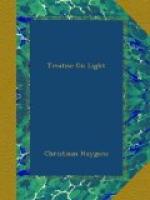Let CP and CS be prolonged and meet the tangent DM at D and Z; and from the point of contact M let MN and MO be drawn as perpendiculars to CP and CS. Now because the angles SCP, GCL, are right angles, the angle PCL will be equal to GCS which was 45 degrees 20 minutes. And deducting the angle LCM, which is 6 degrees 40 minutes, from LCP, which is 45 degrees 20 minutes, there remains MCP, 38 degrees 40 minutes. Considering then CM as a radius of 100,000 parts, MN, the sine of 38 degrees 40 minutes, will be 62,479. And in the right-angled triangle MND, MN will be to ND as the radius of the Tables is to the tangent of 45 degrees 20 minutes (because the angle NMD is equal to DCL, or GCS); that is to say as 100,000 to 101,170: whence results ND 63,210. But NC is 78,079 of the same parts, CM being 100,000, because NC is the sine of the complement of the angle MCP, which was 38 degrees 40 minutes. Then the whole line DC is 141,289; and CP, which is a mean proportional between DC and CN, since MD touches the Ellipse, will be 105,032.
[Illustration]
Similarly, because the angle OMZ is equal to CDZ, or LCZ, which is 44 degrees 40 minutes, being the complement of GCS, it follows that, as the radius of the Tables is to the tangent of 44 degrees 40 minutes, so will OM 78,079 be to OZ 77,176. But OC is 62,479 of these same parts of which CM is 100,000, because it is equal to MN, the sine of the angle MCP, which is 38 degrees 40 minutes. Then the whole line CZ is 139,655; and CS, which is a mean proportional between CZ and CO will be 93,410.
At the same place it was stated that GC was found to be 98,779 parts. To prove this, let PE be drawn in the same figure parallel to DM, and meeting CM at E. In the right-angled triangle CLD the side CL is 99,324 (CM being 100,000), because CL is the sine of the complement of the angle LCM, which is 6 degrees 40 minutes. And since the angle LCD is 45 degrees 20 minutes, being equal to GCS, the side LD is found to be 100,486: whence deducting ML 11,609 there will remain MD 88,877. Now as CD (which was 141,289) is to DM 88,877, so will CP 105,032 be to PE 66,070. But as the rectangle MEH (or rather the difference of the squares on CM and CE) is to the square on MC, so is the square on PE to the square on C_g_; then also as the difference of the squares on DC and CP to the square on CD, so also is the square on PE to the square on gC. But DP, CP, and PE are known; hence also one knows GC, which is 98,779.
Lemma which has been supposed.
If a spheroid is touched by a straight line, and also by two or more planes which are parallel to this line, though not parallel to one another, all the points of contact of the line, as well as of the planes, will be in one and the same ellipse made by a plane which passes through the centre of the spheroid.
Let LED be the spheroid touched by the line BM at the point B, and also by the planes parallel to this line at the points O and A. It is required to demonstrate that the points B, O, and A are in one and the same Ellipse made in the spheroid by a plane which passes through its centre.




